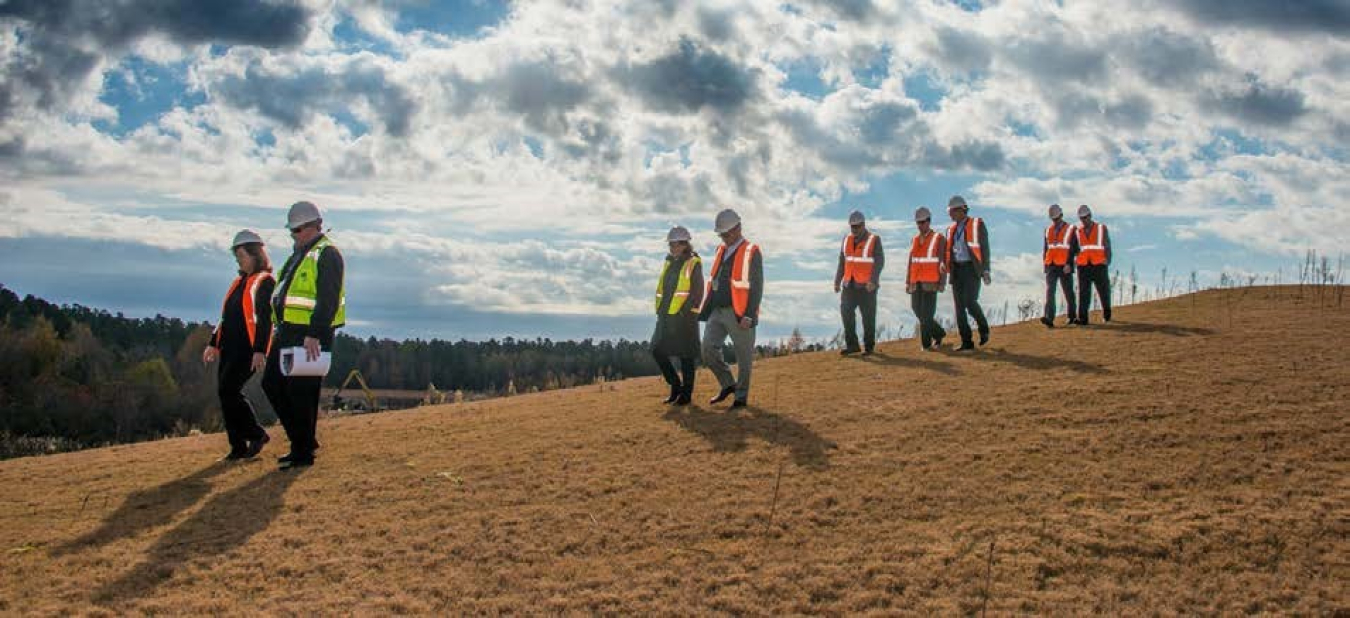Built in the 1950s, the Savannah River Site’s (SRS) huge D Area Powerhouse no longer produces 75 million watts of power...
January 23, 2018
SRNS senior management and Board of Directors inspect a recently completed ash mound at SRS. Over 400,000 cubic yards of ash is being excavated and/or consolidated at SRS.
AIKEN, S.C. – Built in the 1950s, the Savannah River Site’s (SRS) huge D Area Powerhouse no longer produces 75 million watts of power, now cold and dark, that capability is gone forever; however, the legacy of coal ash generated over the decades remains.
Phase one of this extensive cleanup project has successfully consolidated over 90,000 cubic yards of ash and dirt onto an existing SRS ash landfill directly adjacent to the excavation site. As a result, the landfill is highly protected and about 21 acres in size.
Phase two, the single largest portion of this cleanup effort, will safely and efficiently consolidate 335,000 cubic yards of ash, coal fines (small particles) and contaminated soil from two basins into one. Like the landfill, it will also be fully capped with geosynthetic material and a thick earthen cover consisting of fill dirt and grass-covered topsoil.
“We’re pleased with our progress to date; however, consolidating all the ash into two large mounds is only as good as the method used to protect them,” said Savannah River Nuclear Solutions (SRNS) Project Manager Susan Bell. “That’s why we’re using the highest quality, most technologically advanced techniques and materials to ensure this is the case at SRS.”
Bell explained that SRNS, working with their primary sub-contractor, has identified a new, protective barrier made of highly durable plastic sheets covered with a special geotextile material. This material permits rainwater to pass through to the plastic layer where the water runs off within numerous small channels, while preventing two feet of soil and sod from sifting through and clogging these drainage channels.
“This new geosynthetic plastic-based system ensures rainwater runs off a mound, eliminating erosion and other potential issues,” said Bell. “In addition, the new product can be installed faster and at a lower cost.”
D Area Ash Project Engineer Frank Sappington explained that the innovations being incorporated will ensure the project will be completed significantly ahead of schedule while saving U.S. taxpayers more than $300,000.
“We learned a lot during phase one that’s been applied to the entire project,” said Sappington. “With the new process soon to be in place, we feel confident that we’ll be able to walk away from the entire project upon completion having surpassed our goals and high expectations.”
According to Sappington, the credit is shared amongst several contributors, all working together as one team. “The support and guidance we’ve received working with our counterparts in the Department of Energy has been outstanding,” he said. “Combined with the valued input and assistance provided by state and Federal regulators, I just don’t know how we could have achieved more. I believe it’s been a mutually satisfying experience for all involved.”
By the conclusion of the second phase, 1.8 million square feet of geosynthetic material covering approximately 41 acres will have been installed.
“The key is layers of protection,” added Bell. “Each layer has its own purpose, all working together.”
At the completion of the D Area Ash Project, approximately 90 million gallons of water will have been removed from the original basins and over 400,000 cubic yards of ash excavated and/or consolidated. In total, over 90 acres of federal property will have been safely and cost-effectively remediated protecting the environment locally as well as the nearby Savannah River.
“We’re confident our project team will see excellent results in the future because of an insistence on best safety practices, innovative engineering and the use of state of the art materials,” said Bell. “This project is another example of how SRS puts science to work to make the world safer.”
The SRS D Area Ash Project is a result of a closure plan developed and approved by a core team consisting of members of DOE-Savannah River, SRNS and state and federal environmental regulatory agencies.
Since becoming the management and operating contractor at SRS in 2008, SRNS has achieved the cleanup of 85 percent of the site’s 310 square miles to industrial standards.
According to Bell, the challenges involving the safe conversion of these large pond-like holding basins containing wet coal ash into highly protected storage areas for dry coal ash is one of the biggest environmental challenges facing power generating facilities across the U.S., whether commercial or federally-owned. “It’s a world-wide problem,” she said.
Approximately half of all power generated in the U.S. comes from coal-fired power generators at more than 400 coal-fired electric plants in 47 states. According to one study, nearly 100 million tons of coal ash was produced in 2012 alone by the power generating facilities.
About Savannah River Nuclear Solutions
Savannah River Nuclear Solutions is a Fluor-led company whose members are Fluor Federal Services, Newport News Nuclear and Honeywell, responsible for the management and operations of the Department of Energy’s Savannah River Site, including the Savannah River National Laboratory, located near Aiken, South Carolina.
Primary Media Contact
DT Townsend
Savannah River Nuclear Solutions
803.952.7566
lawrence.townsend@srs.gov
DOE Media Contact
Monte Volk
U.S. Department of Energy
803.952.8283
monte.volk@srs.gov

